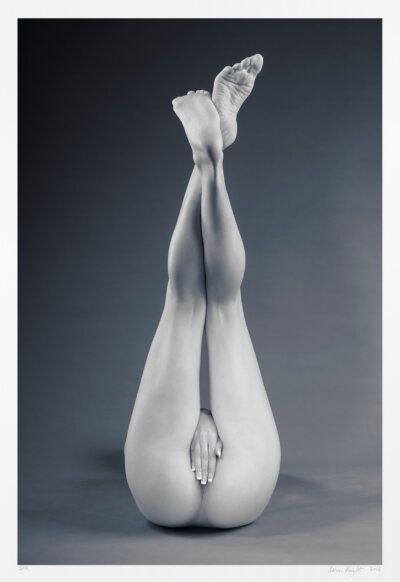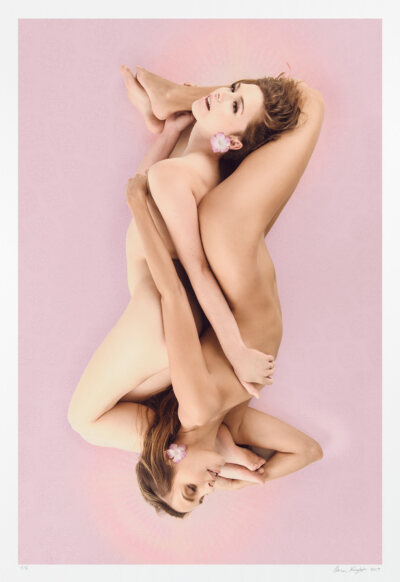Aaron Knight's Technical Process
A minimalist, Knight prefers a single camera and lens, set manually, including manual focus.

Aaron Knight’s fine art nude photography is assembled rather than captured. His artworks contain altered colors, illusory optics, or composites from multiple scenes. The final result is printed through an archival photographic process.
Contents
Achieving deliberate results
To achieve deliberate results, Knight shoots using manual settings, sometimes including manual focus. He may occasionally use a tripod but prefers to stabilize the camera by resting his arm on a solid surface. He will lay on the ground to achieve the desired viewpoint and has even been known to lie in the surf, lifting his camera above incoming waves between shots.
His typical setup is a single Nikon DSLR and one lens. Occasionally, he uses digital or film medium format cameras made by Mamiya or Hasselblad. He has also assembled a DIY underwater DSLR camera kit.
During a photoshoot, Knight spontaneously captures separate exposures of the figure, background, and other elements to be recomposed later. As often as not, Knight’s outdoor photographs have some degree of artificial light mixed in.
Knight uses software to sort, correct, and transform the images. Each image is simplified by removing distractions such as inconsistencies in the backgrounds. As with his hardware, Knight uses a minimalist software workflow with proprietary presets and techniques. Although elements of the image are altered, the subjects’ blemishes, scars, and wrinkles provide relatability. These are humans with real skin rather than the overly-smooth bodies found in advertising.
Editing may include borrowed details like a few tendrils of hair or relocating a water ripple, or combining frames from the same shoot or from entirely different circumstances. Knight can impart subtle mood shifts by darkening a shadow, modifying distracting pebbles, recoloring the sky, or eliminating a distant cell tower.
Significant compilations may include replacing a figure or changing a background. The artist may go as far as splicing the top and bottom halves of a body from separate shots to obtain an impossible pose.
Black and White Photo Technique
Knight gauges the abstract composition of each photograph in black and white. If the image stands on the fundamental appeal of shapes, textures, and lines, it remains tonal—largely free from the distraction of color.
Knight’s monochrome technique pays homage to black-and-white nude photography with hints of hue, such as warm highlights and steely cold shadows to set a mood. It is inspired by classic darkroom chemical processes applied to black-and-white photos: selenium, sepia, and platinum. A selection of two or more colors is mapped across the darks and lights of the image. With digital brushstrokes, Knight adjusts the intensity of the tints in select areas. This effect is sometimes repeated multiple times on the same image.
Color Photo Technique
When it comes to color photography, Knight’s technique employs false color: a tailored palette, rooted in his training in oil painting. These imagined colors are plausible and convincing but don’t duplicate reality. This process helps the viewer see the fictional realm through the artist’s eyes. Through this often painterly effect, color is applied selectively in layers across the image. This technique evokes an emotional response and enhances the illusion of depth as warm-toned subjects appear to protrude from cool-toned surroundings.
Paper and Ink Specifications
The editions are produced using an archival photographic process on a large-format, thermal, inkjet printer. Despite any similarities in name, this process differs significantly from the inkjet or thermal printers many people are familiar with. Thousands of precision nozzles spray thick coats of microscopic droplets of ink in twelve colors. One key ingredient is OEM high-density pigmented inks, which sit on the paper rather than being absorbed like dye-based inks. This makes images that are crisp, opaque, and vibrant.
The other key ingredient in this archival photographic process is smooth, 100% cotton artist's paper. Artists have used cotton paper for etchings and lithographs for hundreds of years. It always has a matte finish—not glossy, not plastic, and not metallic. Knight only uses a heavyweight (300 gsm), museum-quality, natural fiber paper called Pura Smooth which is made in the United States. The process meets archival standards set forth by the Fine Art Trade Guild and the Blue Wool test for photographs that will last generations with no signs of fading. This opaque premium base is free from optical brightening agents (OBAs), acids, or other impurities.
Archival photographs using pigmented inks, such as those sold on this site, are acknowledged as being superior in quality for their lightfastness and longevity. They will outlast older technology such as c-print (chromogenic print) photographs, which have the added disadvantage of being susceptible to unpredictable lifespans, which cannot be exactly determined until it is too late. Pigmented ink photographs will even outlast resin-coated (RC) black-and-white photography.
To properly display and care for your acquisition, check out how to frame and protect your art photography.
Archival photographic process
Knight's training stressed the importance of archival materials, lamenting the deterioration of her favorite early works. Knight recalls viewing a Leonardo da Vinci drawing created with experimental materials. The result was so fragile that it had to be kept in low light and under protective glass. This cemented his commitment to archival processes, even for experiments, in case they yield a result worth keeping.
Knight partners with a local printing technician who specializes in archival photographic process and the exacting standards of original art. This collaboration mirrors the tradition of an artist and lithographer working together to ensure consistent quality in the paper, inks, and outcome. The artist supplies the image, and the technician maintains and calibrates the equipment. Both inspect the photographs for faithful details and colors. If any flaws are detected, no matter how slight, the misprint is destroyed, and the photograph is printed again.
Besides feeling better in your hands, thicker paper lays flatter, is completely opaque, and provides a stronger barrier to any contaminants. Aaron Knight signs and numbers each photograph along the lower margin in graphite pencil.
Environmental and social
Knight evaluates service providers, vendors, and material manufacturers for a commitment to environmental and social responsibility. This reflects his commitment to reduce his environmental impact and operate in a socially responsible manner that promotes fair pay, gender equity, and a workplace free from discrimination.



